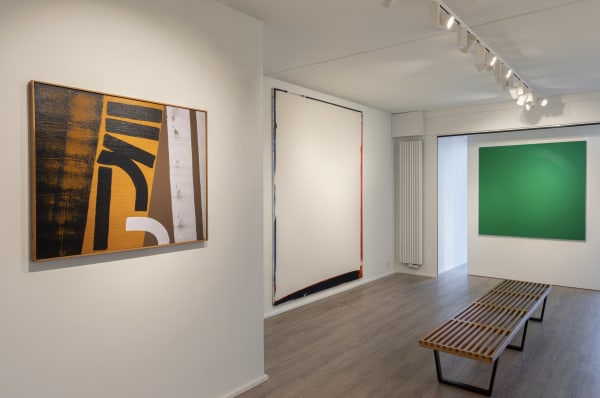Olivier Mosset
Olivier Mosset, a Swiss artist born on June 14, 1944, in Bern, Switzerland, is closely tied to avant-garde art of the 1960s and 1970s, including Minimalism, Conceptual Art, and Radical Painting.
His artistic beginnings were shaped by exposure to American art and culture during his formative years in the US. In the early 1960s, he relocated to New York City, engaging with artists like Stella, Ryman, and LeWitt, who challenged norms. In the mid-1960s, Mosset co-founded “B.M.P.T.” with Buren, Parmentier, and Toroni, challenging authorship and embracing objective, systematic methods. This challenged the “artist’s touch,” emphasizing ideas over objects. In 1967, he declared to only paint black circles, a bold move initiating exploration of seriality and deconstruction. Over time, his work evolved to feature geometric shapes and monochromatic surfaces, emphasizing painting’s essence. In the 1970s, Mosset embraced a conceptual, minimalist approach, even collaborating with fellow artists and musicians. His installations and performances challenged exhibition norms, engaging viewers uniquely. His work is linked with “Radical Painting,” aiming to redefine painting. He expanded boundaries, creating large-scale works blurring painting and sculpture.
Into the 1980s and beyond, Mosset explored diverse media like photography, film, and printmaking. He crafted site-specific installations, engaging with architectural environments. His work featured globally in major galleries and museums, cementing his prominence in contemporary art. His influence on emerging artists is evident in their commitment to exploring art’s essence, embracing simplicity, and challenging norms.
Olivier Mosset resides and works in New York and Tucson, Arizona.
-

Brussels’s New Gallery
Grand Opening 7 September - 22 November 2023 QG BrusselsQG is pleased to announce the inauguration of a space based in Brussels, set to open on September 7, 2023. The inaugural exhibition will feature a group show with works...Read more -

L’Art et son Concept
9 April - 3 July 2022 QG KnokkeDon't miss QG Gallery's group exhibition, "L'ART ET SON CONCEPT," curated by Victor Hugo Riego. Inspired by Ghislain Mollet-Viéville, a renowned expert in minimal and conceptual art, this exhibition explores the role of ideas in art. Discover how conceptual artists challenge traditional perceptions and transform the relationship between artwork and viewer. Experience a thought-provoking showcase that deconstructs established codes and invites self-reflection.Read more -

The Edge
1 August - 13 September 2020 QG KnokkeStep into the captivating exhibition, "The Edge," at QG Gallery. Experience the transformative power of abstraction as renowned artists redefine artistic expression. Marvel at Josef Albers, Alan Charlton, Sam Francis, Gunther Förg, Olivier Mosset, Kenneth Noland, Richard Nonas, and Jan Schoonhoven's innovative works. Join us on a journey of artistic exploration and embrace the beauty of the unknown.Read more
-

Contrast
12 January - 30 March 2019 QG BrusselsCONTRAST exhibition at QG GALLERY showcases 10 renowned artists, including Warhol, Dubuffet, and Sugimoto. From abstract to figurative, painting to photography, the focus is on black and white as the highest contrast. Discover Olivier Mosset's monochromes, Niele Toroni's imprints, and Vasarely's Op Art. François Morellet's numbered canvases and Robert Barry's conceptual words add depth. Jean Dubuffet's collage reflects Art Brut inspiration. Experience a contrasting journey through artworks spanning decades, inviting contemplation and celebrating the power of black and white.Read more -

Power of Repetition
6 September - 22 December 2018 QG BrusselsPower of Repetition exhibition explores the impact of repetition in art from the 20th century to the present. BMPT collective, including Buren, Mosset, and Toroni, challenged authorship through neutral repetitive patterns. Andre revolutionized sculpture by inviting viewers to walk upon his flat, ground-level works. Rickey mastered abstract kinetic sculptures with controlled movements. McCollum's Perfect Vehicles showcased unique variations of reproduced vases. Gorchov's concave paintings and Whitney's colorful grids regain recognition. Joseph's two-color paintings evoke mood and place, while Charlton's monochromes emphasize physicality. Experience Yves Klein's iconic IKB blue, symbolizing luminosity and spirituality.Read more






